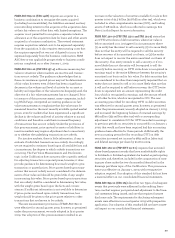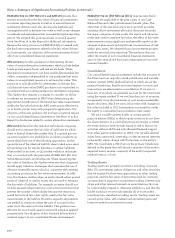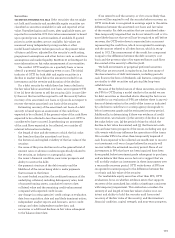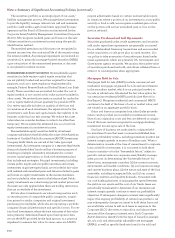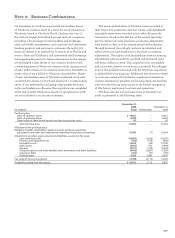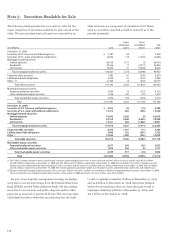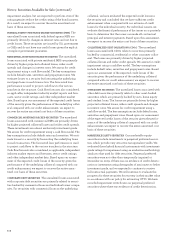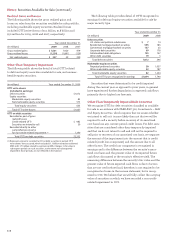Wells Fargo 2009 Annual Report Download - page 108
Download and view the complete annual report
Please find page 108 of the 2009 Wells Fargo annual report below. You can navigate through the pages in the report by either clicking on the pages listed below, or by using the keyword search tool below to find specific information within the annual report.
Note 1: Summary of Significant Accounting Policies (continued)
is indicated if the sum of undiscounted estimated future
net cash flows is less than the carrying value of the asset.
Impairment is permanently recognized by writing down the
asset to the extent that the carrying value exceeds the
estimated fair value.
Operating Lease Assets
Operating lease rental income for leased assets is recognized
in other income on a straight-line basis over the lease term.
Related depreciation expense is recorded on a straight-line
basis over the life of the lease, taking into account the esti-
mated residual value of the leased asset. On a periodic basis,
leased assets are reviewed for impairment. Impairment loss is
recognized if the carrying amount of leased assets exceeds
fair value and is not recoverable. The carrying amount of
leased assets is not recoverable if it exceeds the sum of the
undiscounted cash flows expected to result from the lease
payments and the estimated residual value upon the eventual
disposition of the equipment. Leased assets are written down
to the fair value of the collateral less cost to sell when 120
days past due.
Pension Accounting
We account for our defined benefit pension plans using
an actuarial model required by accounting guidance on
retirement benefits. This model allocates pension costs over
the service period of employees in the plan. The underlying
principle is that employees render service ratably over this
period and, therefore, the income statement effects of
pensions should follow a similar pattern.
In 2008, we began measuring our plan assets and benefit
obligations using a year-end measurement date. The change
in the accounting provisions for retirement benefits did
not change the amount of net periodic benefit expense
recognized in our income statement.
One of the principal components of the net periodic
pension expense calculation is the expected long-term rate
of return on plan assets. The use of an expected long-term
rate of return on plan assets may cause us to recognize
pension income returns that are greater or less than the
actual returns of plan assets in any given year.
The expected long-term rate of return is designed to
approximate the actual long-term rate of return over time
and is not expected to change significantly. Therefore, the
pattern of income/expense recognition should closely match
the stable pattern of services provided by our employees over
the life of our pension obligation. To ensure that the expected
rate of return is reasonable, we consider such factors as
(1) long-term historical return experience for major asset
class categories (for example, large cap and small cap
domestic equities, international equities and domestic fixed
income), and (2) forward-looking return expectations for
these major asset classes. Differences between expected and
actual returns in each year, if any, are included in our net
actuarial gain or loss amount, which is recognized in OCI.
We generally amortize any net actuarial gain or loss in excess
of a 5% corridor in net periodic pension expense calculations
over the next 13 years.
We use a discount rate to determine the present value of
our future benefit obligations. The discount rate reflects the
rates available at the measurement date on long-term high-
quality fixed-income debt instruments and is reset annually
on the measurement date. In 2008, we changed our measure-
ment date from November 30 to December 31 as required by
accounting guidance on retirement benefits.
Income Taxes
We file consolidated and separate company federal income
tax returns, foreign tax returns and various combined and
separate company state tax returns.
We account for income taxes in accordance with the
Income Taxes topic of the Codification, which requires two
components of income tax expense: current and deferred.
Current income tax expense approximates taxes to be paid
or refunded for the current period and includes income tax
expense related to our uncertain tax positions. We determine
deferred income taxes using the balance sheet method. Under
this method, the net deferred tax asset or liability is based on
the tax effects of the differences between the book and tax
bases of assets and liabilities, and recognizes enacted
changes in tax rates and laws in the period in which they
occur. Deferred income tax expense results from changes in
deferred tax assets and liabilities between periods. Deferred
tax assets are recognized subject to management’s judgment
that realization is more likely than not. A tax position that
meets the “more likely than not” recognition threshold is
measured to determine the amount of benefit to recognize.
The tax position is measured at the largest amount of benefit
that is greater than 50% likely of being realized upon settle-
ment. Foreign taxes paid are generally applied as credits to
reduce federal income taxes payable. Interest and penalties
are recognized as a component of income tax expense.
Stock-Based Compensation
We have stock-based employee compensation plans as more
fully discussed in Note 18 in this Report. Under accounting
guidance for stock compensation, compensation cost recog-
nized includes cost for all share-based awards.
Earnings Per Common Share
We compute earnings per common share by dividing net
income (after deducting dividends on preferred stock) by the
average number of common shares outstanding during the
year. We compute diluted earnings per common share by
dividing net income (after deducting dividends and related
accretion on preferred stock) by the average number of
common shares outstanding during the year, plus the effect
of common stock equivalents (for example, stock options,
restricted share rights, convertible debentures and warrants)
that are dilutive.





